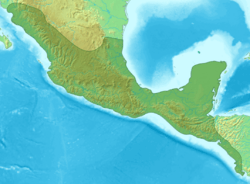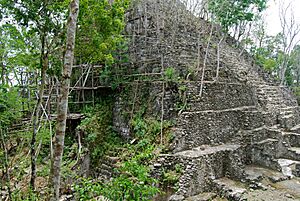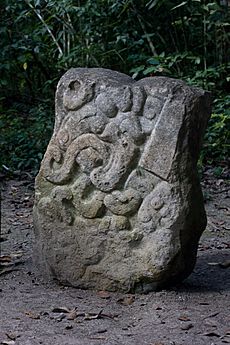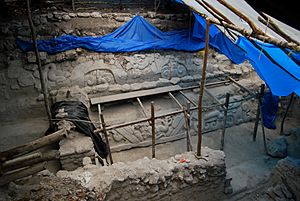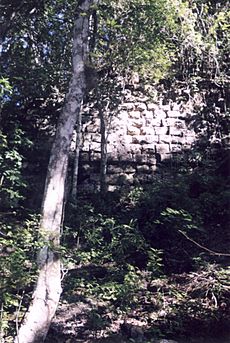El Mirador facts for kids

La Danta at El Mirador
|
|
| Location | Petén Department, Guatemala |
|---|---|
| Region | Petén Department |
| Coordinates | 17°45′18″N 89°55′14″W / 17.75500°N 89.92056°W |
| History | |
| Founded | Middle Preclassic |
| Periods | Middle Preclassic to Terminal Classic |
| Cultures | Maya civilization |
| Site notes | |
| Archaeologists | Ian Graham, Bruce H. Dahlin, Ray T. Matheny, Carlos Morales-Aguilar |
| Architecture | |
| Architectural styles | Early Maya, Central Peten |
El Mirador means "the lookout" or "the viewpoint." It is a very large ancient city built by the Maya civilization. This amazing settlement is located in the northern part of Guatemala, in the Petén Department.
El Mirador was a major Maya city during the Middle and Late Preclassic periods. This was a long time ago, from about 1000 BC to 250 AD. It is part of a special area called the Mirador-Calakmul Karst Basin.
Contents
Discovering the Ancient City
People knew about some ruins in the Mirador area as early as 1885. However, El Mirador itself did not get much attention for a long time.
Early Explorations
In 1962, a person named Ian Graham spent time at El Mirador. He created the first map of the area. This was an important step in understanding the site.
Archaeological Projects Begin
Detailed studies of El Mirador started in 1978. Archaeologists Bruce Dahlin and Ray Matheny led these projects. They were surprised by what they found. Most of the huge buildings were much older than other famous Maya cities like Tikal. They were built centuries earlier, during the Preclassic era.
Modern Research and Media Attention
In 2003, Richard D. Hansen began a large project at El Mirador. His team included experts from many universities around the world. They worked to study, protect, and save the ancient structures. Their discoveries have been featured in many documentaries. You might have seen them on channels like National Geographic or the History Channel.
History of El Mirador
El Mirador grew into a powerful city from about 600 BCE to 1 CE. It was at its busiest around 300 BCE. After this, construction stopped for a while, and the city might have been empty for many years.
City Life and Size
Later, people returned and built more structures during the Late Classic era. The city was finally abandoned around the end of the 9th century. The main part of El Mirador covers about 10 square miles (26 square kilometers). It has thousands of buildings, some as tall as 236 feet (72 meters).
Farming in the Jungle
One reason El Mirador grew so big was the many bajos, which are seasonal swamps. Jungle soil usually does not have many nutrients. But the Maya found a clever way to farm. They brought thousands of tons of mud from the swamps to create rich farming terraces. They added lime to the soil, which helped many crops grow. These crops included corn, squash, beans, and cacao. When the soil lost its nutrients, they just added more mud.
Amazing Architecture
El Mirador has many unique buildings called "triadic structures." These are large platforms with three pyramids on top. There are about 35 of these structures.
- El Tigre: This complex is about 180 feet (55 meters) tall.
- La Danta: This temple is about 236 feet (72 meters) tall from the forest floor. It is one of the largest pyramids in the world by total volume. When you include the huge platform it sits on, La Danta is considered one of the largest ancient structures ever built.
- Los Monos: This complex is also very large, reaching 157 feet (48 meters) high.
Many buildings were covered with cut stone. These stones were decorated with large stucco masks. These masks showed the gods of Maya mythology. Archaeologists believe the city was carefully planned from the start. Buildings were lined up with each other and possibly with the sun's movements.
Ancient Highways
El Mirador also has many long, raised roads called sacbeob. These roads are like ancient highways. They are 6 to 20 feet (2 to 6 meters) high and 65 to 164 feet (20 to 50 meters) wide. They connected important parts of El Mirador. They also linked El Mirador to other major cities in the Mirador Basin. For example, one sacbe connects El Mirador to Nakbe, about 7.5 miles (12 km) away. Another goes to El Tintal, 12.4 miles (20 km) away.
Why the City Declined
The city and its neighbors thrived between 300 BCE and 1 CE. But by about 150 CE, El Mirador was mostly abandoned. Before this, a large wall was built around parts of the city. This suggests that people might have felt threatened.
Another problem was deforestation. The Maya used a lot of wood to make stucco. Stucco is a plaster used to cover buildings, floors, and even pottery. It made surfaces smooth and easy to paint. But making stucco needed huge amounts of wood. To make one ton of stucco, five tons of wood were needed.
When trees were cut down, the soil became loose. Rain then washed the soil into the bajos. The rich mud that the Maya used for farming was buried under layers of clay. This made it impossible to grow enough food. Eventually, crop failures likely led to starvation and the city's decline.
Later Reoccupation
Around 700 CE, some parts of El Mirador were reoccupied. People built smaller structures among the ruins. They even took stones from the old buildings to build new ones. These later residents were skilled artists and writers. They created unique "codex-style ceramics." These were fine pottery pieces with black drawings on a cream background. This reoccupation was short-lived. By 900 CE, the area was mostly abandoned again.
El Mirador Today
Today, Richard D. Hansen leads the Mirador Basin Project. He believes that the many ancient sites in the basin might have formed the first well-organized political state in Mesoamerica.
El Mirador is a stunning example of ancient Maya civilization. However, it is very remote, which makes it hard for tourists to visit. The government of Guatemala plans to make El Mirador a key part of the Cuatro Balam Conservation and Development project.
Threats to El Mirador
This amazing area of ancient Maya cities faces many dangers. These include massive deforestation, looting, and damage from logging roads. These roads also make it easier for people to settle illegally in the area. The Mirador Basin has many sites, and many are among the largest and oldest in the Maya world. Out of 26 known sites, only 14 have been studied. Experts believe about 30 more sites are still waiting to be discovered.
Since 2003, a non-profit group called Global Heritage Fund has been working to protect and preserve El Mirador.
See also
 In Spanish: El Mirador (ciudad maya) para niños
In Spanish: El Mirador (ciudad maya) para niños
- List of Maya sites
- Jungle tourism
- K'àak' Chi'
- La Muerta
- List of tallest ancient structures


